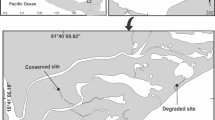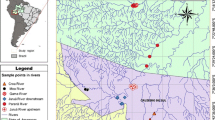Abstract
A new approach is chosen to visualize ecosystem health by using parasite bioindicators in Segara Anakan Lagoon, a brackish water ecosystem at the southern Java coast, Indonesia. Three fish species (Mugil cephalus, Scatophagus argus, Epinephelus coioides) were collected in two different years and sampling sites and studied for ecto- and endoparasites. Additional data were taken for E. coioides from two further sites in Lampung Bay, Sumatra, and for E. fucoguttatus out of floating cages from a mariculture facility in the Thousand Islands, Jakarta Bay, North Java. The parasite fauna of fishes inside the lagoon was characterized by a high number of ecto- and a low number of endoparasites, the endoparasite diversity was relatively low and the prevalence of ectocommensalistic trichodinid ciliates was high. These parameters were chosen to indicate the biological conditions inside the lagoon. In E. coioides during rainy season, the prevalence of trichodinid ciliates was highest inside the lagoon (55%) compared with 27% in an open-net-cage mariculture and 5.7% in free-living specimens in Lampung Bay. The endoparasite diversity (Shannon-Wiener) was lowest in fish from Segara Anakan lagoon (0.66) compared with fish from an open-net-cage mariculture (0.71) and free-living specimens (1.39). Results for E. fuscoguttatus from the mariculture site in the Thousand Islands, a relatively undisturbed marine environment, demonstrated high parasite diversity (1.58) in the cultivated fish, a high number of endoparasites, and no trichodinids. A star graph is used to visualize the parasite composition for the different fishes, sampling sites, and conditions, using (1) the prevalence of trichodinid ciliates, (2) the ecto/endoparasite ratio and (3) the endoparasite diversity as bioindicators. The application of the star graph is suggested to be a suitable tool to visualize and monitor environmental health under high parasite biodiversity conditions within tropical ecosystems. It can also support a better communication to stake holders and decision makers in order to monitor environmental impact and change.







Similar content being viewed by others
References
Bell S, Morse S (2003) Measuring sustainability: learning by doing. Earthscan, London, Sterling, VA
Bush AO, Lafferty KH, Lotz JM, Shostak AW (1997) Parasitology meets ecology on its own terms: Margolis et al. revisited. J Parasitol 83:575–583
Diamant A, Banet A, Paperna I, von Westernhagen H, Broeg K, Kruener G, Koerting W, Zander S (1999) The use of fish metabolic, pathological and parasitological indices in pollution monitoring. II The Red Sea and Mediterranean. Helgoland Mar Res 53:195–208
FAO Inland Water Resources and Aquaculture Service (FIRI) (2006) National Aquaculture Sector Overview - Indonesia. National Aquaculture Sector Overview Fact Sheets. FAO, Rome. Available via FIGIS from http://www.fao.org/figis/servlet/static?dom=countrysectorandxml=naso_indonesia.xml
Galli P, Crosa G, Mariniello L, Ortis M, D’Amelio S (2001) Water quality as a determinant of the composition of fish parasite communities. Hydrobiologia 452:173–179
Graney RL Jr, Cherry DS, Cairns J Jr (1983) Heavy metal indicator potential of the Asiatic clam (Corbicula fluminea) in artificial stream systems. Hydrobiologia 102:81–88
Harris E (2001) Status of Indonesian fisheries today and the research needed. Proceedings of the JSPS-DGHE International Symposium on fisheries science in tropical area, 21–25. August 2000. Faculty of Fisheries and Marine Science-IPB Bogor, Indonesia, pp 62–66
Holtermann P, Burchard H, Jennerjahn TC (2009) Hydrodynamics of the Segara Anakan lagoon. Reg Environ Change Spec Iss: doi:10.1007/s10113-008-0075-3
Jakob E, Palm HW (2006) Parasites of commercially important fish species from the southern Java coast, Indonesia, including the distribution pattern of trypanorhynch cestodes. Verhandl Ges Ichthyol 5:165–191
Jennerjahn TC, Nasir B, Pohlenga I (2009) Spatio-temporal variation of dissolved inorganic nutrients related to hydrodynamics and land use in the mangrove-fringed Segara Anakan Lagoon, Java, Indonesia. Reg Environ Change Spec Iss: doi:10.1007/s10113-008-0077-1
Khan RA, Thulin J (1991) Influence of pollution on parasites of aquatic animals. Adv Parasitol 30:201–238
Klein B (1926) Ergebnisse mit einer Silbermethode bei Ciliaten. Arch Protistenkd 56:243–279
Klein B (1958) The "dry" silver method and its proper use. J Protozool 5:99–103
Kuchta R, Scholz T, Vlčková R, Říha M, Walter T, Yuniar AT, Palm HW (2009) Revision of tapeworms (Cestoda: Bothriocephalidea) from lizardfish (Saurida: Synodontidae) from the Indo-Pacific region. Zootaxa 1977:55–67
Lafferty KD (1997) Environmental parasitology: what can parasites tell us about human impacts on the environment? Parasitol Today 13:251–255
Landsberg JH, Blakesley BA, Reese RO, McRae G, Forstchen PR (1998) Parasites of fish as indicators of environmental stress. Env Monitor Assess 51:211–232
Leong TS (1997) Control of parasites in cultured marine finfishes in Southeast Asia—an overview. Int J Parasitol 27:1177–1184
MacKenzie K, Williams HH, Williams B, McVicar AH, Siddall RI (1995) Parasites as indicators of water quality and the potential use of helminth transmission in marine pollution studies. Adv Parasitol 35:86–245
Magurran AE (1988) Ecological diversity and its measurement. Croom Helm, London
Marcogliese DJ (2005) Parasites of the superorganism: are they indicators of ecosystem health? Int J Parasitol 35:705–716
Marcogliese DJ, Cone DK (1997) Parasite communities as indicators of ecosystem stress. Parasitologia 39:27–232
Mersch J, Jeanjean A, Spor H, Pihan J-C (1992) The freshwater mussel Dreissena polymorpha as a bioindicator for trace metals, organochlorines, and radionuclides. Limn Akt 4:227–244
Moser M (1991) Parasites as biological tags. Parasitol Today 7:1–4
Ogut H, Palm HW (2005) Seasonal dynamics of Trichodina spp. on whiting (Merlangius merlangus) in relation to organic pollution on the eastern Black Sea coast of Turkey. Parasitol Res 96:149–153
Overstreet RM (1997) Parasitological data as monitors of environmental health. Parassitologia 39:169–175
Palm HW (1999) Ecology of Pseudoterranova decipiens (Krabbe, 1878) (Nematoda: Anisakidae) from Antarctic waters. Parasitol Res 85:638–646
Palm HW (2000) Trypanorhynch cestodes from Indonesian coastal waters (East Indian Ocean). Folia Parasitol 47:123–134
Palm HW (2004) The Trypanorhyncha Diesing, 1863. PKSPL-IPB, Bogor
Palm HW, Dobberstein RC (1999) Occurrence of trichodinid ciliates (Peritricha: Urceolariidae) in the Kiel Fjord, Baltic Sea, and its possible use as a biological indicator. Parasitol Res 85:726–732
Palm HW, Schröder P (2001) Cestode parasites from the elasmobranchs Heptranchias perlo (Bonnaterre, 1788) and Deania spp. Jordan et Snyder, 1902 from the Great Meteorbank, central East-Atlantic. Aquat Liv Res 14:137–144
Palm HW, Damriyasa IM, Linda OIBM (2008) Molecular genotyping of Anisakis Dujardin, 1845 (Nematoda: Ascaridoidea: Anisakidae) larvae from marine fish of Balinese and Javanese waters, Indonesia. Helminthologia 45:3–12
Riemann F (1988) Nematoda. In: Higgins RP, Thiel H (eds) Introduction to the study of meiofauna. Smithsonian, Washington, DC, pp 293–301
Rückert S (2006) Marine Fischparasiten in Indonesien: Befallssituation und Bedeutung für die Marikultur von Zackenbarschen. PhD-thesis, Heinrich-Heine University of Düsseldorf, Germany, 1-181
Rückert S, Palm HW, Klimpel S (2008) Parasite fauna of seabass (Lates calcarifer) under mariculture conditions in Lampung Bay, Indonesia. J Appl Ichthyol 24:321–327
Rückert S, Klimpel S, Al-Quraishy S, Mehlhorn H, Palm HW (2009a) Transmission of fish parasites into grouper mariculture (Serranidae: Epinephelus coioides (Hamilton, 1822)) in Lampung Bay, Indonesia. Parasitol Res 104:523–532. doi:10.1007/s00436-008-1226-7
Rückert S, Hagen W, Yuniar AT, Palm HW (2009b) Metazoan parasites of fishes and their potential use as biological indicators in the Segara Anakan Lagoon, Indonesia. Reg Environ Change Spec Iss: doi:10.1007/s10113-008-0076-2
Sasal P, Mouillot D, Fichez R, Chifflet S, Kulbicki M (2007) The use of fish parasites as biological indicators of anthropogenic influences in coral-reef lagoons: a case study of Apogonidae parasites in New-Caledonia. Mar Poll Bull 54:1697–1706
Shuanglin D, Kehou P, Brockmann U (2000) Review on effects of mariculture on coastal environment. J Ocean Univ Qingdao 30:572–582
Sures B (2003) Accumulation of heavy metals by intestinal helminths in fish: an overview and perspective. Parasitol 126:53–60
Sures B, Reimann N (2003) Analysis of trace metals in the Antarctic host-parasite system Notothenia coriiceps and Aspersentis megarhynchus (Acanthocephala) caught at King George Island, South Shetland Islands. Pol Biol 26:680–686
Sures B, Siddall R (2003) Pomphorhynchus laevis (Palaeacanthocephala) in the intestine of chub (Leuciscus cephalus) as an indicator of metal pollution. Int J Parasitol 33:65–70
Vidal-Martínez VM, Aguirre-Macedo ML, Vivas-Rodríguez CM, Moravec F (1998) The macroparasite communities of the red grouper, Epinephelus morio, from the Yucatan Peninsula, Mexico. Proceedings of the 50th Annual meeting of The Gulf and Caribbean Fisheries Institute, November 9-14, Mérida, Yucatán. 764-779
Williams HH, MacKenzie K (2003) Marine parasites as pollution indicators: an update. Parasitol 126:S27–S41
Williams HH, MacKenzie K, McCarthy AM (1992) Parasites as biological indicators of the population biology, migrations, diet, and phylogenetics of fish. Rev Fish Biol Fisher 2:144–176
Wiryawan B, Marsden B, Susanto HA, Mahi AK, Ahmad M, Poespitasasri H (eds) (1999) Lampung Coastal Resources Atlas. Government of Lampung Province and Coastal Resources Management Project (Coastal Resources Centre, University of Rhode Island and Centre for Coastal and Marine Resources Studies, Bogor Agricultural University). Bandar Lampung, Indonesia
Yeomans WE, Chubb JC, Sweeting RA (1997) Use of protozoan communities for pollution monitoring. Parassitologia 39:201–212
Yuniar AT, Palm HW, Walter T (2007) Crustacean fish parasites from Segara Anakan Lagoon, Java, Indonesia. Parasitol Res 100:1193–1204
Acknowledgments
This paper was presented at the International Symposium of the Fisheries Society of the British Isles (FSBI) in Cardiff, Wales, 21-25.07.2008. Financial support was provided by the German Academic Exchange Service (DAAD) (SR), the German Federal Ministry for Education and Science (BMBF Grant No. 03F0391A, (HWP, SR)) within the framework of the joint Indonesian-German research program SPICE (Science for the Protection of Indonesian Coastal Marine Ecosystems), and the German Research Council (DFG PA 664/4-1 and 2) (HWP). We are thankful to two anonymous reviewers that helped to improve the manuscript.
Author information
Authors and Affiliations
Corresponding author
Rights and permissions
About this article
Cite this article
Palm, H.W., Rückert, S. A new approach to visualize ecosystem health by using parasites. Parasitol Res 105, 539–553 (2009). https://doi.org/10.1007/s00436-009-1423-z
Received:
Accepted:
Published:
Issue Date:
DOI: https://doi.org/10.1007/s00436-009-1423-z




